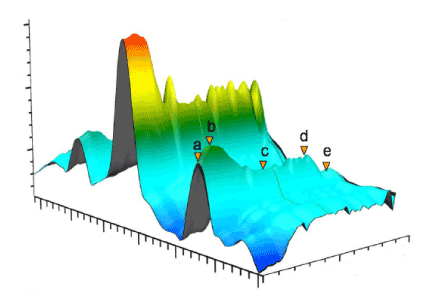It cannot be denied that NMR biospectroscopy has several advantages that attribute to this technique a great potential towards viral diagnostic routines. This technique cannot be overlooked, and must be considered a possible alternative for theoretical 13C chemical shift, 14N, and 2H quadrupole coupling–constant studies of hydrogen bonding for measurement and calculation of 13C and 15N NMR chemical–shift tensors in DNA/RNA of gum cancer cells identification. Several people die every day for lack of a quick, reliable and relatively inexpensive diagnosis. In conjunction with NMR biospectroscopic analysis, multivariate data analysis provides powerful support for interpretation and pattern recognition. Finally, NMR biospectroscopy approaches combined with multivariate analysis provide a powerful weapon in studies for development of rapid diagnostics, which can be extended to several cancers of different types and strains.
chemical shift, quadrupole, coupling–constant, hydrogen bonding, tensors, gum cancer cells, NMR biospectroscopic analysis
As has been seen, theoretical 13C chemical shift, 14N, and 2H quadrupole coupling–constant studies of hydrogen bonding for measurement and calculation of 13C and 15N NMR chemical–shift tensors in DNA/RNA of gum cancer cells identification that are used nowadays are a double–edged sword, where advantages and disadvantages are mutually observed. Direct methods are more specific, however, they take time and are more expensive. Indirect methods are faster and cheaper but are less specific. Based on this assessment, theoretical 13C chemical shift, 14N, and 2H quadrupole coupling–constant studies of hydrogen bonding for measurement and calculation of 13C and 15N NMR chemical–shift tensors in DNA/RNA of gum cancer cells identification emerges as a tool with the potential to solve the deficiencies found by standard techniques. Theoretical 13C chemical shift, 14N, and 2H quadrupole coupling–constant studies of hydrogen bonding for measurement and calculation of 13C and 15N NMR chemical–shift tensors in DNA/RNA of gum cancer cells identification is known to have a fast response and provide reliable information about the sample composition and has been used in several oncological applications for screening or diagnosis of gum cancer cells [1-10].
Knowing that theoretical 13C chemical shift, 14N, and 2H quadrupole coupling–constant studies of hydrogen bonding for measurement and calculation of 13C and 15N NMR chemical–shift tensors in DNA/RNA of gum cancer cells identification is fast, non–destructive and has a low–cost, we can imagine that, with new studies developed in this area, soon we can count with NMR biospectroscopic tools in clinics and hospitals, being used for routine diagnostic or acting as a reliable diagnostic aiding tool. For this, only a minimal amount of collected bio fluid would be needed. Spectral acquisition of this bio fluid would be done by an instrument coupled to a computer where this spectral information would be automatically imported into software that would perform all computational procedures in real time (pre–processing and multivariate classification), based on a theoretical 13C chemical shift, 14N, and 2H quadrupole coupling–constant studies of hydrogen bonding for measurement and calculation of 13C and 15N NMR chemical–shift tensors in DNA/RNA of gum cancer cells identification (Figure 1).

Figure 1. Simulation of 13C chemical shift, 14N, and 2H quadrupole coupling–constant studies of hydrogen bonding for measurement and calculation of 13C and 15N NMR chemical–shift tensors in DNA/RNA of gum cancer cells identification
NMR biospectroscopic techniques are based on the interaction between electromagnetic radiation with the sample. This interaction can provide valuable information from the sample compositional point of view. Theoretical 13C chemical shift, 14N, and 2H quadrupole coupling–constant studies of hydrogen bonding for measurement and calculation of 13C and 15N NMR chemical–shift tensors in DNA/RNA of gum cancer cells identification is one of the most well–known biospectroscopic techniques. In biological samples, the range between 1800 to 900 cm−1 is known as the biofingerprint region because it has a high density of information regarding important biomolecules. The field of study where NMR biospectroscopic tools are used to analyze biological samples has become known as biospectroscopy and has been widely used in chemometric approaches involving the identification of bacteria, viruses, cancer diagnosis, forensic entomology, among others.
This study was supported by the Cancer Research Institute (CRI) Project of Scientific Instrument and Equipment Development, the National Natural Science Foundation of the United Sates, the International Joint BioSpectroscopy Core Research Laboratory Program supported by the California South University (CSU), and the Key project supported by the American International Standards Institute (AISI), Irvine, California, USA.
- Heidari, C. Brown, “Study of Composition and Morphology of Cadmium Oxide (CdO) Nanoparticles for Eliminating Cancer Cells”, J Nanomed Res., Volume 2, Issue 5, 20 Pages, 2015.
- A. Heidari, C. Brown, “Study of Surface Morphological, Phytochemical and Structural Characteristics of Rhodium (III) Oxide (Rh2O3) Nanoparticles”, International Journal of Pharmacology, Phytochemistry and Ethnomedicine, Volume 1, Issue 1, Pages 15–19, 2015.
- A. Heidari, “An Experimental Biospectroscopic Study on Seminal Plasma in Determination of Semen Quality for Evaluation of Male Infertility”, Int J Adv Technol 7: e007, 2016.
- A. Heidari, “Extraction and Preconcentration of N–Tolyl–Sulfonyl–Phosphoramid–Saeure–Dichlorid as an Anti–Cancer Drug from Plants: A Pharmacognosy Study”, J Pharmacogn Nat Prod 2: e103, 2016.
- A. Heidari, “A Thermodynamic Study on Hydration and Dehydration of DNA and RNA−Amphiphile Complexes”, J Bioeng Biomed Sci S: 006, 2016.
- A. Heidari, “Computational Studies on Molecular Structures and Carbonyl and Ketene Groups’ Effects of Singlet and Triplet Energies of Azidoketene O=C=CH–NNN and Isocyanatoketene O=C=CH–N=C=O”, J Appl Computat Math 5: e142, 2016.
- A. Heidari, “Study of Irradiations to Enhance the Induces the Dissociation of Hydrogen Bonds between Peptide Chains and Transition from Helix Structure to Random Coil Structure Using ATR–FTIR, Raman and 1HNMR Spectroscopies”, J Biomol Res Ther 5: e146, 2016.
- A. Heidari, “Future Prospects of Point Fluorescence Spectroscopy, Fluorescence Imaging and Fluorescence Endoscopy in Photodynamic Therapy (PDT) for Cancer Cells”, J Bioanal Biomed 8: e135, 2016.
- A. Heidari, “A Bio–Spectroscopic Study of DNA Density and Color Role as Determining Factor for Absorbed Irradiation in Cancer Cells”, Adv Cancer Prev 1: e102, 2016.
- A. Heidari, “Manufacturing Process of Solar Cells Using Cadmium Oxide (CdO) and Rhodium (III) Oxide (Rh2O3) Nanoparticles”, J Biotechnol Biomater 6: e125, 2016.

